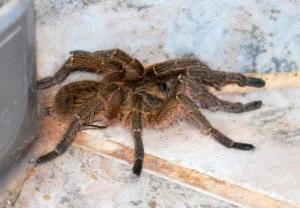In South Africa we also have tarantulas.
Ours are brown,
and we call them Baboon Spiders.
This is a lady that was washed out of her burrow next to the kitchen drain after very heavy rain one day. We brought her in to show the grandsons, as part of their ongoing wildlife education and conservation. We spread her legs out from her ‘death curl’ and I managed to get some nice close-ups. You can see her size, her fangs and some eyes and we turned her over to photograph her underside. We left her to one side to add to our Curiousity Collection.
Suddenly she waved gently, and slowly. I thought I was hallucinating! But, no, as she warmed up, she revived! Before she went scuttling off, to inevitably pop up to terrify me, we placed her safely in the garage to recover and choose a new home.
Females stay in their burrows, or close by, while males roam around.
Here is an excerpt from an article about them.
The Baboon Spiders of South Africa by Dr Ansie Dippenaar-Schoeman
Baboon spiders or tarantulas, as they are known outside Africa, are the giants of the spider world. The last two leg segments resemble the finger of a baboon hence, the common name, baboon spiders. The first South African spider known from literature was a baboon spider mentioned in 1702 by Petiver. More than a hundred years later in 1832 the first baboon spider Mygale atra was described from South Africa and only in 1871 the first genus Harpactira was established for Southern African baboon spiders.
Southern Africa has a rich fauna of baboon spiders, represented by seven genera and 42 species. They belong to the family Theraphosidae, a very diverse family, represented by 86 genera and about 612 species worldwide. The theraphosids have a pantropical distribution and are known from Africa, the Far East, Australia as well as parts of South, Central and North America.
The baboon spiders are large, with a body size varying from 13-90 mm. They are very hairy and their colour varies between hues of brown, grey, yellow to black. The carapace is frequently decorated with radiating bands while the abdomen has variegated markings.
They are easily recognized by their large size, strong, hairy bodies, and the thick pad of hair present ventrally on the last two leg segments.
A Baboon spider may live up to 25 years and take about 10 years to mature.
Baboon spiders prey on a variety of small animals such as: insects – ants, beetles (e.g. tenebrionids), cicadas, cockroaches, Orthoptera (e.g. grasshoppers, locusts, crickets), Isoptera (termites), Lepidoptera (mostly Saturniidae and Sphingidae, Hymenoptera (driver ants of the family Dorylidae); arachnids – spiders, solifugids and scorpions; millipedes, reptiles, amphibians and snails: frogs and lizards.
Some theraphosids are known to deliver painful bites. Harpactira lightfooti,a baboon spider known from Cape Town and the Paarl region in South Africa are fairly aggressive and people sometimes get bitten. They produce a neurotoxic venom. Bites in humans results in a burning pain at the bite site. The patients, after about two hours, start to vomit; they show marked signs of shock, become pale and have difficulty walking. Bites are however, never fatal.
This one lives in my bathroom
Stock photo to give you an idea of size







Glad to see someone else doesn’t squash spiders automatically.
Some of mine have names…
LikeLiked by 1 person
I’m not so afraid anymore, as I’m learning more and more about them all
LikeLiked by 1 person